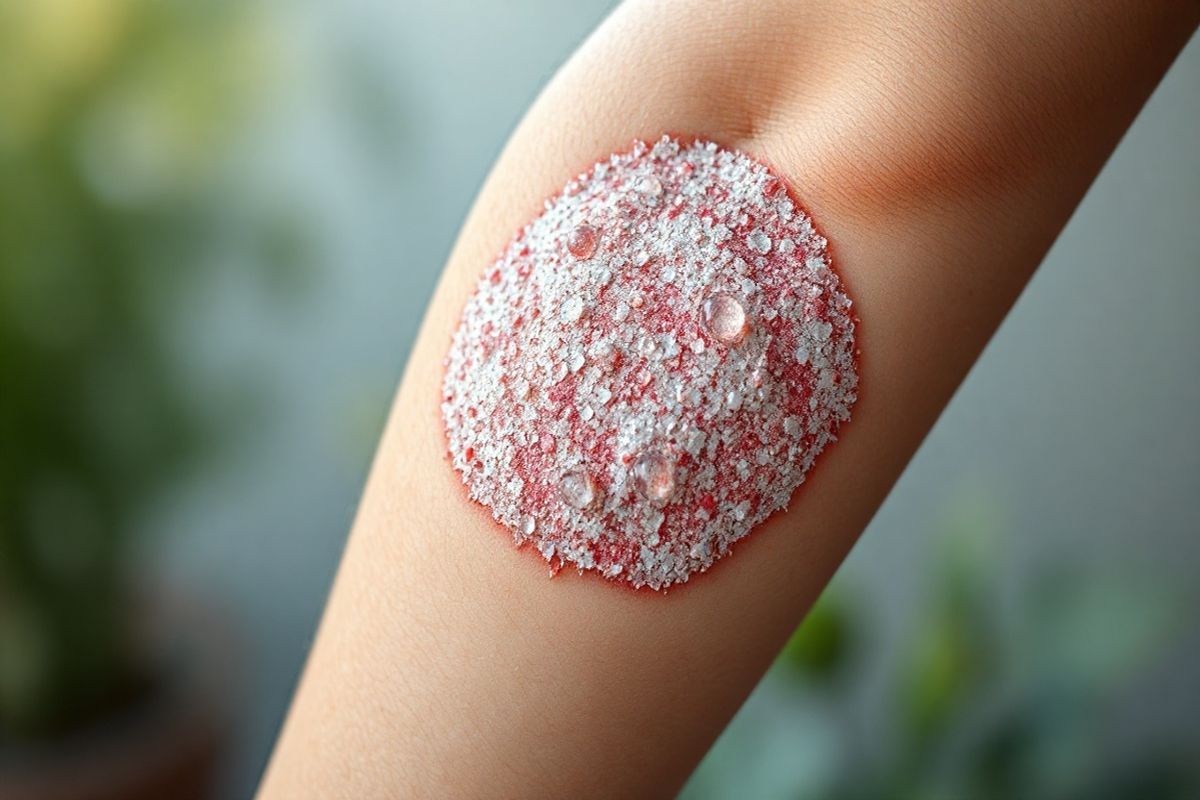Table of Contents
Understanding Psoriasis: Distinguishing It from Other Skin Conditions

psoriasis is a chronic autoimmune disorder that manifests predominantly on the skin, characterized by the rapid growth of skin cells leading to thick, scaly patches. This condition is not only a cosmetic issue but also significantly impacts the quality of life of those affected. Understanding psoriasis requires distinguishing it from other skin conditions that may exhibit similar symptoms. This article delves into the unique characteristics of psoriasis, compares it with other skin disorders, outlines key symptoms for identification, discusses effective diagnostic methods, and explores various treatment approaches.
The Unique Characteristics of Psoriasis: What Sets It Apart

psoriasis is often confused with other skin conditions due to its visible symptoms. However, its underlying pathophysiology and clinical presentation are distinct. The hallmark of psoriasis is the accelerated life cycle of skin cells, which can lead to a buildup of dead skin on the surface of the epidermis. This phenomenon results in the formation of plaques—areas of raised, inflamed skin covered with silvery-white scales. These plaques typically occur on the elbows, knees, trunk, and scalp, although they can appear anywhere on the body (Mayo Clinic, 2021) [1].
Types of Psoriasis
There are several types of psoriasis, each with its own unique features:
- Plaque Psoriasis: The most common form, presenting as dry, raised patches covered with scales.
- Guttate Psoriasis: Often triggered by infections such as strep throat, it appears as small, drop-shaped lesions.
- Inverse Psoriasis: Characterized by smooth, red patches in skin folds, often exacerbated by friction and moisture.
- Pustular Psoriasis: This type manifests with pus-filled blisters surrounded by red skin, commonly on palms or soles.
- Erythrodermic Psoriasis: A rare and severe form that can cover the entire body with a red, peeling rash (NIAMS, 2023) [2].
Symptoms Overview
Common symptoms of psoriasis include:
- Thickened, red skin covered with silvery scales.
- Dry, cracked skin that may bleed.
- Itching, burning, or soreness.
- Cycles of flare-ups followed by periods of remission.
- Changes in nail appearance, including pitting and discoloration (Cleveland Clinic, 2023) [3].
Common Skin Conditions: A Comparative Overview

To appreciate the uniqueness of psoriasis, it is essential to compare it with other prevalent skin conditions:
| Condition | Main Symptoms | Key Differences from Psoriasis |
|---|---|---|
| Eczema | Red, itchy, inflamed skin; often weeping | More intense itching, often linked to allergies |
| Rosacea | Facial redness, flushing, visible blood vessels | Primarily affects the face; not scaly |
| Seborrheic Dermatitis | Scaly patches, redness, especially on the scalp | Greasy scales compared to the dry, flaky scales of psoriasis |
| Contact Dermatitis | Red, itchy rash from exposure to irritants/allergens | Often resolves after removing irritant |
| Fungal Infections | Red, itchy, circular patches; often with a clear center | Fungal infections typically have a more defined border |
By understanding these differences, individuals can better identify psoriasis and seek appropriate treatment.
Identifying Psoriasis Symptoms: Key Indicators to Recognize
Recognizing the symptoms of psoriasis is vital for timely diagnosis and management. Key indicators include:
- Plaques: Raised patches of skin that are red and covered with silvery scales.
- Itching and Pain: Affected areas may itch or be painful, impacting daily life.
- Nail Changes: Pitting, thickening, or separation from the nail bed can occur.
- Scalp Involvement: Psoriasis can cause dandruff-like scaling on the scalp.
- Joint Symptoms: Some patients may also experience psoriatic arthritis, leading to joint pain and swelling (Mayo Clinic, 2021) [1].
Effective Diagnosis: How Healthcare Professionals Differentiate Skin Disorders
Diagnosing psoriasis involves a combination of clinical evaluation and patient history. Healthcare professionals typically follow these steps:
- Physical Examination: Visual inspection of the skin, scalp, and nails to identify characteristic plaques.
- Medical History: Assessing family history and any triggers that may have led to flare-ups.
- Skin Biopsy: In uncertain cases, a small sample of skin may be taken for laboratory analysis to confirm the diagnosis (Cleveland Clinic, 2023) [3].
Differential Diagnosis
It is crucial to differentiate psoriasis from other skin conditions, as treatment options may vary significantly. For example, eczema treatments may not be effective for psoriasis, and vice versa.
Treatment Approaches: Managing Psoriasis vs. Other Skin Conditions
While there is currently no cure for psoriasis, several effective treatment options can help manage symptoms and reduce flare-ups. Treatment strategies vary based on the severity of the condition and may include:
Topical Treatments
- Corticosteroids: These are the most commonly prescribed medications for mild to moderate psoriasis (Mayo Clinic, 2023) [1].
- Vitamin D Analogues: Such as calcipotriene, which help slow skin cell growth.
- Retinoids: Topical retinoids can reduce inflammation and promote skin turnover.
Phototherapy
- UVB Phototherapy: Involves exposing the skin to UVB light under medical supervision.
- PUVA: Combines a light-sensitizing medication with UVA light therapy.
Systemic Treatments
For moderate to severe psoriasis, systemic treatments may be necessary:
- Methotrexate: Reduces inflammation and slows skin cell production.
- Biologics: Target specific parts of the immune system; options include etanercept and adalimumab (NIAMS, 2023) [2].
- Oral Retinoids: Such as acitretin, which reduce skin cell growth.
Lifestyle Modifications
In addition to medical treatments, lifestyle changes can significantly improve quality of life for individuals with psoriasis:
- Diet: A healthy diet may help reduce flare-ups.
- Stress Management: Reducing stress through mindfulness or therapy can be beneficial.
- Moisturization: Regular use of moisturizers helps manage dryness and scaling.
FAQ
Q: Is psoriasis contagious?
A: No, psoriasis is not contagious. It is an autoimmune condition that cannot be spread from person to person.
Q: Can psoriasis go away completely?
A: While psoriasis can go into remission, it is a chronic condition that may recur over time.
Q: What triggers psoriasis flare-ups?
A: Common triggers include stress, infections, skin injuries, certain medications, and environmental factors.
Q: How can I manage psoriasis at home?
A: Regular moisturizing, avoiding known triggers, and adhering to prescribed treatments can help manage symptoms effectively.
References
- Mayo Clinic. (2021). psoriasis - Symptoms and causes. https://www.mayoclinic.org/diseases-conditions/psoriasis/symptoms-causes/syc-20355840
- NIAMS. (2023). Psoriasis. https://www.niams.nih.gov/health-topics/psoriasis
- Cleveland Clinic. (2023). Psoriasis: What It Is, Symptoms, Causes, Types & Treatment. https://my.clevelandclinic.org/health/diseases/6866-psoriasis










